Choosing an Email Ticketing System: Our Top 11 Picks


If you’re looking for a way to get your company’s inbox under control, an email ticketing system might be a good investment. To help you in your search, this article will discuss email ticketing system benefits and best practices, plus several popular email ticketing platforms that might be a good fit for your team.
What is an email ticketing system?
An email ticketing system is a tool that helps a team or organization manage its incoming email requests. The tool turns each email received into a “ticket” that the team can use to track the request through to resolution.
Although a business can handle email using a regular email account, a ticketing system is often preferred because it provides features that help prevent emails from getting lost in the shuffle and makes it easier for teams to work through the queue collaboratively.
What are the biggest advantages of deploying an email ticketing system?
There are many advantages to switching to a dedicated email management system. Three primary benefits of making the switch are an increase in organization and efficiency, greater opportunities for building client relationships, and the ability to quantify your team’s efforts.
All of your conversations, organized and in one place
Think about how many times in your life you’ve forgotten to reply to an email — it’s probably more times than you can count! Given that fact, it’s pretty easy to understand how an email can fall through the cracks in a business setting where there may be ten times as many messages waiting for an answer.
Rather than having emails scattered throughout individual contributors' mailboxes, email ticketing systems bring all of your emails into one location. Once part of the system, you can assign the conversations to specific people, add tags to track issues and priority levels, and automate anything that doesn’t require a human touch.
While poor communication can happen for a wide assortment of reasons, often it’s just due to poor organization, and having a dedicated email solution keeps everyone on the same page.
Build relationships through personalized support
Most people view ticketing systems as impersonal and cold, but having all your customer, client, or student communications managed through a dedicated platform can pave the way for more personalized responses.
Email management tools remove the need for your customers to rehash previous requests. Instead, agents can view prior tickets and information like a customer’s order history or how long a client has been with your company from within the ticket window. This gives your team all they need to offer a customized solution without much back and forth.
An easier way to measure success
So much of the world today is driven by data, which makes using software like Gmail or Outlook a real problem. Neither product offers any analytics, so managers are stuck with the tiresome task of manually creating spreadsheets and pivot tables each time leadership wants to see what their team has been working on.
The fact that manually creating reports is incredibly boring should be enough to inspire the search for an automated solution. But manually creating reports is beyond boring — it’s unsustainable. Leadership teams require information at a moment’s notice, and managers who update data by hand are working at a disadvantage.
Most email ticketing systems come equipped with out-of-the-box reporting functionality that shows statistics on ticket volume, team productivity, and trending issues.
Our top 11 email ticketing system picks
Think your team might benefit from using an email ticketing system to manage your incoming and outgoing emails? Here are 11 options to consider as you start your search:
Help Scout
Hiver
Salesforce Service Cloud
Freshdesk
Front
Jira Service Management
Zendesk
HubSpot Service Hub
Dixa
Jitbit
ServiceNow
1. Help Scout
Best email ticketing system for most teams.
Originally developed for customer service teams, Help Scout has evolved into a digital communications platform that takes the heavy lifting out of email management for teams in the support queue and beyond. While Help Scout embraces the “ticketing” system, it approaches all of your customer communications as conversations.
Each email a team receives lands in their Help Scout shared inbox, where team members can work collaboratively to respond. If a specific agent or team is better suited to respond to the conversation, the email can be assigned to the right person for the job. Employees can also mention each other or leave private notes in the email thread, preventing forwarded email chains and keeping all information in one place.
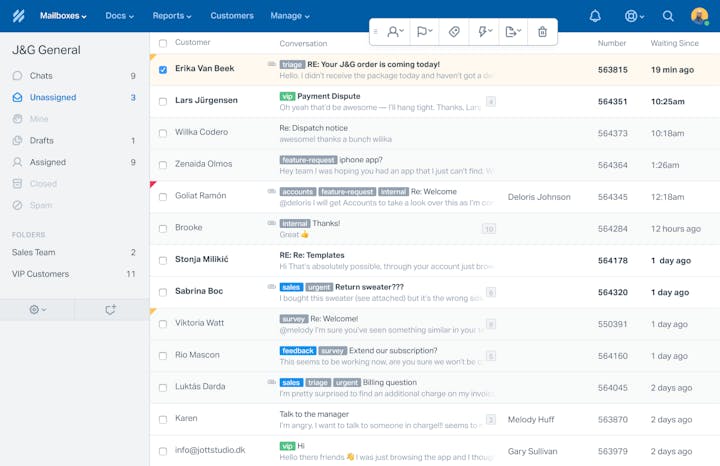
To ensure that each team member knows who is working on which request at any given time, Help Scout provides collision detection. When someone is viewing a conversation, the system flags the message with a yellow triangle in the queue. If an employee is writing a response, that triangle switches to red. Visual cues prevent duplicate work and keep miscommunications from reaching your customers' inboxes.
Teams can increase productivity with saved replies — shared email templates that make it easy for your team to send out pre-written, standardized responses to frequently asked questions. In addition, you can further streamline your process with workflows that reduce busy work like tagging or assigning conversations.
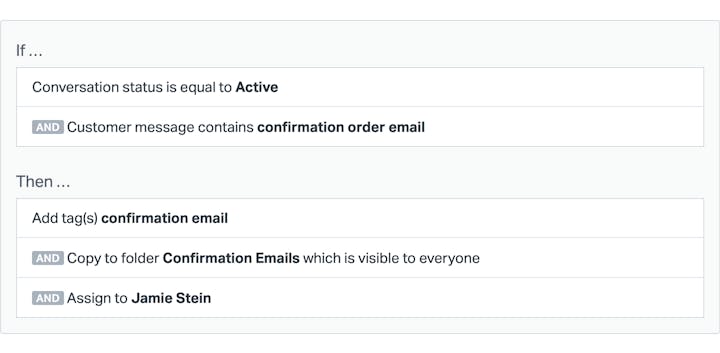
AI features make it easier for your team to respond to conversations more quickly. AI summarize can help get teammates up to speed on an issue by creating bulleted on-demand summaries of conversations.
The AI assist editor tool can help polish your conversation replies before hitting send. The feature can shorten or lengthen a response, adjust its tone to be friendlier or more professional, check for spelling and grammatical errors, and even translate the copy into another language.
Help Scout reporting dashboards let you analyze your teams’ productivity, helping inform business decisions. Give non-customer-facing staff access to your reports through the light user role — a license on Plus and Pro plans that allows cross-organizational collaboration without additional cost.

Beyond email, Help Scout offers many other communication tools to help your team better meet the needs of your community, such as native live chat, a knowledge base builder, and proactive messaging. All three of these features and access to an assortment of integrationscome with Help Scout’s standard plan at no additional charge.
Price: Free trial available. Plans start at $20/user per month.
Learn more about Help Scout:
2. Hiver
Best email ticketing system for teams using Google Workspace.
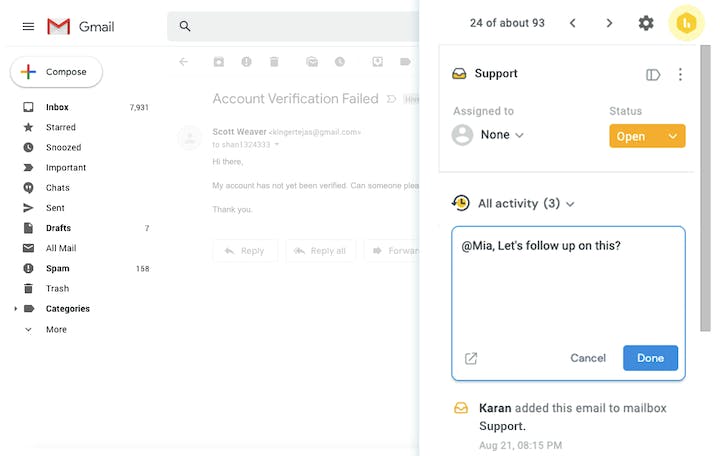
If your team relies on Gmail but is starting to find that Google products don’t quite cut it when managing email at scale, you might consider Hiver.
Hiver is an email ticketing system built for use with Gmail. You can think of it as an extension that allows your team to view and collaboratively manage customer communications from within the native Gmail interface. Hiver adds the ability to assign emails across your team, use shared email templates, leave internal notes, tag conversations, and create simple automations.
The tool also offers the ability to provide live chat and a help center if your team is ready to expand beyond an email support system.
Price: Free trial available. Plans start at $15/user per month.
3. Salesforce Service Cloud
Best email ticketing system for companies already using Salesforce.
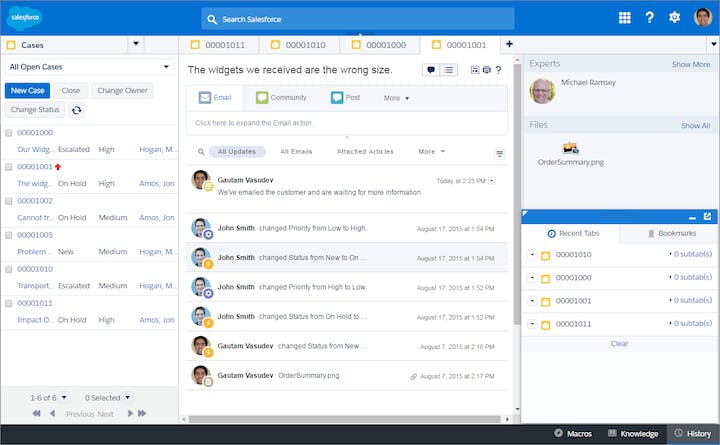
Salesforce is well known for its customer relations management (CRM) product, but it also offers several other customer-focused tools.
Salesforce Service Cloud is their ticketing system, catering to use cases such as customer service, field service, self-service, and employee service (HR teams, IT teams, etc.). Email management features include a shared inbox, ticket assignments, custom views, reporting, and tools for cross-team collaboration. Service Cloud can also handle additional channels like live chat, voice, and self-service.
When it comes to cost, viewing their pricing page can be overwhelming. Add-ons and a seemingly endless table of features may make it hard to understand which plan your company needs. Still, the seamless integration and holistic customer view make Service Cloud a valuable tool if your business is already a Salesforce customer.
Price: Free trial available. Plans start at $25/user per month.
4. Freshdesk
Best email ticketing system for teams looking for a freemium option.

Freshdesk is a ticketing system often compared to Zendesk (another platform we’ll discuss in this post) due to its robust feature set. However, one thing that sets it apart from Zendesk is its freemium plan.
Freshdesk’s free plan converts all emails and social contacts into tickets that are viewable in a shared inbox. Teams can assign tickets, use shared canned responses, leave private notes, and tag tickets. There is also basic reporting and a knowledge base builder available.
This base-level plan is a great place to start if your company only offers email support and has a limited number of agents. However, it is missing critical features like collision detection, automations, and the ability to add other channels like live chat, so if your business is looking to scale, you’ll likely need to opt for a paid plan.
Price: Free trial and plan available. Paid plans start at $15/agent per month.
5. Front
Best email ticketing system for teams that want to use the same tool for personal and shared email management.

Front is a ticketing system that enables teams to manage just about any channel (email, social, SMS, live chat, etc.) through a shared inbox.
The tool boasts many collaborative features, such as email assignments, canned responses, shared drafts, and internal discussions. You can also utilize tags, set up automations, and view reporting dashboards.
An interesting aspect of Front is its ability to integrate personal account access into the tool. For instance, you can view your personal inbox (e.g., john.smith@yourcompany.com) and your shared inboxes (support@, accounting@, sales@, etc.) all from within the Front user interface. You can also integrate your calendar, making it easy to send out one-click meeting requests without leaving the tool.
Price: Free trial available. Plans start at $19/person per month.
6. Jira Service Management (formerly Jira Service Desk)
Best email ticketing system for engineering or IT teams that use Jira.
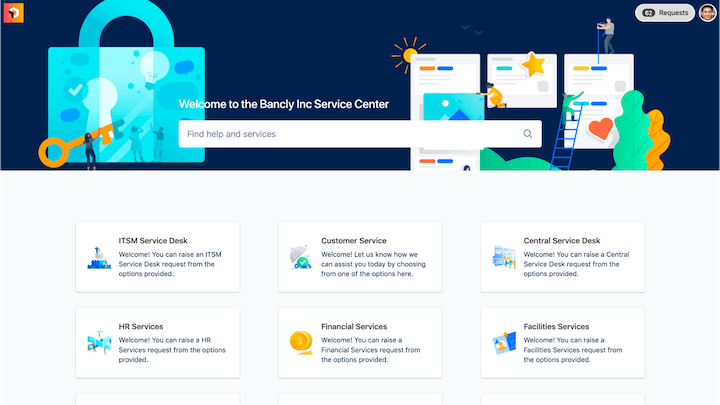
Originally launched as Jira Service Desk in 2013, Jira Service Management is a platform that assists IT teams in managing service requests, incident and problem responses, asset control, and knowledge access.
The software has the standard features you would expect to find in an email ticketing system. In addition, routing capabilities that make it easy to move tickets across multiple help desks, a low cost of entry, and a recognizable UI make onboarding easy for most technical teams.
Jira Service Management offers a free plan that may appeal to smaller teams. However, potential customers should be aware that this plan only has a 2GB file storage limit, is missing some functionality, and doesn’t come with support access beyond self-help in the Atlassian Community.
Price: Free trial and plan available. Paid plans start at $20/agent per month.
7. Zendesk
Best email ticketing system for enterprise companies with dedicated development resources.
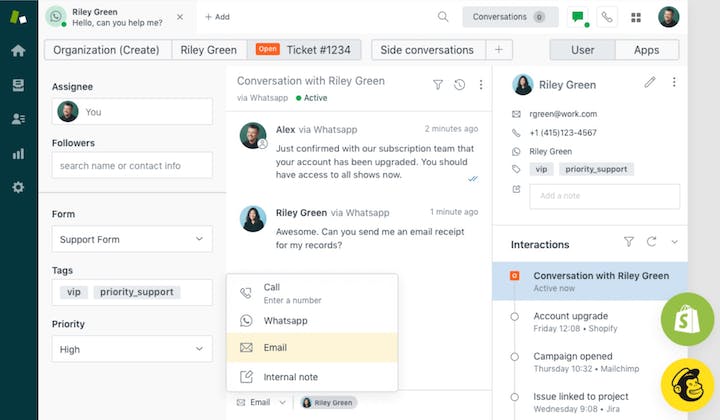
Zendesk is a comprehensive communications platform supporting the management of email, live chat, voice, social media, SMS, and self-service channels. The software includes the shared inbox and collaborative features seen in other email ticketing tools, as well as more specialized features.
What separates Zendesk from the competition is its ability to be customized for just about any use case and integrated with over 1,000 different software products, creating a centralized hub for all your customer, client, or student data. However, most of these integrations and customizations are not plug-and-play solutions. Many require basic technical aptitude at a minimum or developer skills at most, meaning that smaller teams may need to hire a contractor to assist with deployment.
For those with the technical resources or budget needed for customization, Zendesk could be a flexible ticketing solution.
Price: Free trial available. Plans start at $19/user per month.
8. HubSpot Service Hub
Best email ticketing system for companies using other Hubspot products.

HubSpot is a company that produces marketing, sales, and service software. While its service arm is less well known, Service Hub should be on your shortlist if you’re already using the company’s other products.
Like Freshdesk, Service Hub offers a free plan that enables you to manage email from a shared inbox. Teams can assign tickets to the right agents and ease the burden of repetitive responses by using canned snippets and email templates, and leadership can view reporting dashboards that outline team performance. The free plan also offers the ability to provide live chat and Facebook Messenger support.
While a free option is nice, prospective customers should know that many of the best features HubSpot offers (ticket routing, customer feedback surveys, workflow automations, etc.) are only available on higher-tiered plans.
Price: Free trial and plan available. Paid plans start at $45/user per month.
9. Dixa
Best email ticketing system for teams interested in automatic routing.
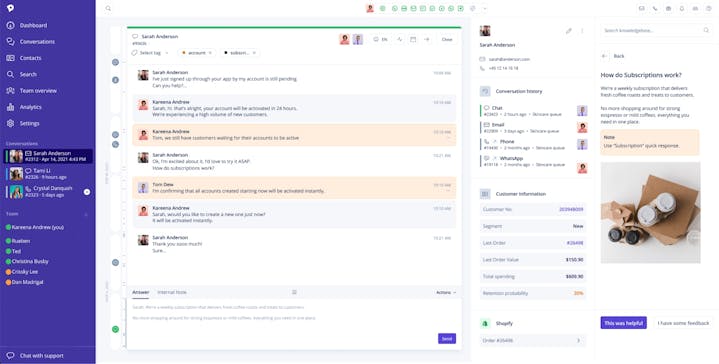
Dixa is an omnichannel customer service platform that brands itself as a “ticketing system alternative.”
Dixa’s approach to email is a little different than some of the other options on this list. Instead of having all of your team’s email moved into a shared inbox, Dixa automatically assigns each conversation to the employee best equipped to respond to the request. The platform bases the routing on both priority and agent skill set and ensures that your team will spend more time focused on customer responses and less time cherry-picking the email queue.
The tool offers many of the same email features provided by other email ticket software on this list (customer timelines, internal notes, tagging, reports, etc.). It can also natively offer live chat, voice, social messaging, and self-service support.
While Dixa is impressive, it may not be the best pick for teams only looking for an email management tool. Their $39/agent per month plan only covers the Dixa Messenger channel — those wanting email support will need to opt for their Growth plan, which starts at $89/agent per month with a five seat minimum.
Price: Free trial available. Plans including email start at $89/agent per month (five seat minimum).
10. Jitbit
Best email ticketing system for organizations that prefer to self-host.

Whether you’re seeking a service desk or a help desk, Jitbit could be a good email ticketing system to consider. It has all the features teams need for email management, such as a shared inbox, email assignments, collision detection, canned responses, tagging, reporting, and a knowledge base builder. In addition, its simple UI and asset management feature makes it an excellent choice for IT service desks.
One aspect of Jitbit that sets it apart is that it offers two options for accessing its platform — hosted as a software as a service (SaaS) product or self-hosted, meaning your team can download the software and run it on your own servers. While most teams will prefer the ease of using a web-based, hosted product, companies that manage sensitive information and want complete control over their data may choose to keep their ticketing system in-house.
On the topic of sensitive information, medical facilities will appreciate that Jitbit’s hosted (SaaS) offering is considered HIPAA compliant. A few companies on this list, such as Help Scout, also offer HIPAA compliance as a feature, but it’s not a standard offering on all systems.
Price: Hosted (SaaS) plans start at $29 per month; self-hosted software starts at $1699.
11. ServiceNow
Best email ticketing system for teams that require a large-scale ITSM solution.

ServiceNow is one of the hottest information technology service management (ITSM) tools currently on the market. Targeting the enterprise-level user, ServiceNow has an impressive list of features ranging from standard email ticketing tools to asset and cost tracking to an online employee center that provides a central place for staff to access services quickly.
ServiceNow is a powerful system with features that smaller groups may not require, such as vendor management or dynamic translation functionality. While it’s not necessary to use every feature available in a tool, extra features tend to raise plan pricing, and paying for things you’ll never use is far from ideal.
Price: Pricing not publicly listed; quote available on request.
How can different teams use an email ticketing system?
If you’re wondering how you might use a ticketing system to increase efficiency and improve communication throughout your organization, here are a few ways that different teams may use the platform:
Customer support: Support teams collaboratively manage and resolve customer requests, track emerging issues, and surface customer data for the broader company using ticketing tools.
IT: IT teams track and resolve technical issues reported within your organization. They may also use a ticketing system for other purposes, such as asset management.
Finance: Finance teams use ticketing systems to handle incoming messages related to billing, payroll, and expense reimbursements.
Marketing: Marketers regularly email outside collaborators, such as content and design freelancers, PR firms, and industry partners. Ticketing systems help document those conversations.
Human resources: People operations teams may use ticketing systems to manage employee or applicant communications surrounding hiring or benefits administration.
Organizations outside of traditional business settings use ticketing systems for similar reasons. For instance:
In education: College and university departments, such as admissions, housing, and financial aid, rely on ticketing systems to ease the burden of student requests. Given the seasonal nature of education, departments are often overwhelmed during specific points in the academic year. Ticketing systems allow schools to streamline processes and ramp up quickly for busier periods.
In healthcare: Medical offices and insurance companies use email ticket systems to track and manage patient communications securely. Bound by the Health Insurance Portability and Accountability Act (HIPAA), these teams need data security features that regular email providers can’t supply.
What factors should you consider before investing in an email ticketing system?
When you begin your search for just about any software solution, it becomes apparent rather quickly that your options seem endless. Email ticketing software is no exception; after all, there are 11 tools mentioned in this article alone!
The best way to approach your search is to create a list of everything your new solution will need for your team to be successful in using it. Then take that list, and use it to help narrow down your options.
Here are a few factors worth considering as you create your list:
1. How much email do you receive?
The first thing you should consider is how many emails you currently receive in a month and whether you expect this number to change in the near future. Ticket volume is important as it may impact the type of email help desk software you choose as well as the cost of the service.
Don’t worry if you currently manage email through Gmail or Outlook and can’t get ahold of exact numbers; even a general estimate will be helpful.
2. How many people will need access to the tool?
Much like email volume, the type of tool and the price will vary depending on how many people will need to have access. While you may be tempted to tally up the members of your support team and move on, there is merit to thinking more broadly.
Product team members benefit from being exposed to customer feedback via support tickets, business leaders may value the ability to pull their own reporting data, and teams across your organization can help provide context when requests require a specialist’s expertise.
Though most tools do charge based on user seats, others focus on ticket count or offer free access to team members who won’t personally be answering emails.
3. What are the weak spots in your current process?
Before you evaluate what you want in a new tool, take a beat to figure out what parts of your email management process work well and what needs improvement.
For instance, here are some common pain points you may be experiencing:
A lack of visibility and accountability when it comes to work distribution.
Emails routinely falling through the cracks or, on the flip side, people receiving multiple responses from your team for a single email.
You hear the same complaints from your customers “a lot,” but you can’t get buy-in from leadership to fix the problem.
Your team struggles with repetitive inbox cleanup tasks (forwarding emails to other departments, deleting spam, and answering the same questions over and over).
Email ticketing systems come with features that can help ease the burden of problems like these. Acknowledging which issues are present for your team and the features needed to resolve them should help inform your software choice.
4. What specialized features does your team need?
All email ticketing systems have features that make email handling easy, but many platforms offer tools designed for specific work functions. For instance, some systems will offer IT departments a way to keep track of tech inventory. Another might have an add-on to give appliance companies the ability to track field service appointments.
Though features like these are common, you won’t find every feature on every platform. Some solutions will cater to specific industries, some will be customizable via add-on features, and others may not offer specialty features at all.
5. How does your audience want to connect with you?
You might be scratching your head since this article focuses on email ticketing systems, but your audience’s preferences matter!
Beyond email, it’s common for teams to offer channels like phone, live chat, social media messaging, or self-service options like a knowledge base. Your customers, clients, or students may prefer one channel over another, and your ability to meet that need may impact whether they choose to do business with you.
While you don’t need to roll out additional channels to start, it’s good to know what your audience prefers and whether your ticketing system will allow you to offer it now or in the future.
6. What is your budget?
While it’s fun to consider all of the cool things possible with an email to ticket system, it’s important to remember that you don’t necessarily need to have all the bells and whistles. Ticketing systems are available for every budget, and knowing how much you’re working with will help you filter solutions accordingly.
7. Do you have access to technical support resources?
If you have basic tech skills, chances are that you’ll be able to complete the initial setup of your email ticketing system on your own or with some help from the software’s online knowledge base. However, if you need a lot of customizations or integrations, you will likely need the help of a developer.
If you don’t have developer talent in-house and your budget won’t cover hiring out, you should ensure that whatever option you choose is something that will work out of the box.
What are the best practices for using an email ticketing system?
Once you’ve picked out your system, it’s time to set your team up for success. Here are some best practices to keep in mind as you get started with your new ticketing software.
Learn the software, and train your team
When learning software, many people will get to know the base functionality and never dig deeper. Get to know the ins and outs of your new system and gain the knowledge required to make it work at full capacity for you and your team.
Get organized
It’s a lot easier to start out organized than it is to sort out a mess later. Outline your tagging and prioritization systems from the start. Develop a process flow for how tickets will move through your team, and document it so everyone is always on the same page.
Create shared resources
Create email templates for your most commonly received requests, and if your software allows for it, create an internal knowledge base with helpful information for agents. Shared resources lend to quicker resolution times, make it easier to ramp up new hires, and empower your team to be more self-sufficient.
Automate
While it only takes a second to assign an email to another team or add a tag, those seconds can start to add up fast. Building automated workflows to add tags, assign tickets based on keywords, or escalate tickets based on time conditions can make your process more efficient and save time.
Implement SLAs
Service Level Agreements, or SLAs, outline the level of service your customers and clients can expect to receive from your company. Some common SLAs relating to email communications might be:
Business hours: When people can expect your team to respond to email requests.
First response time: The maximum amount of time someone can expect to wait before receiving an initial response to their email.
Average response time: The typical amount of time in between responses.
Maximum time to resolution: The maximum amount of time someone can expect to wait for a complete resolution of their issue.
SLAs are important because they set expectations for your customers and help your team prioritize tasks.
Share your data and insights
Use your email ticketing system’s analytics features to create custom reports that illustrate team performance and provide a glimpse into your audience’s feelings about your product, services, and organization.
Ready to invest in a new email ticketing system?
Email support at scale can be overwhelming, but it doesn’t need to be that way. Switching to a ticketing email system can save time and effort and help you communicate more effectively inside and outside your organization.
Did you know that we also have this guide available in German and French?
The Supportive Weekly: A newsletter for people who want to deliver exceptional customer service.









